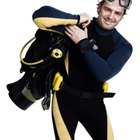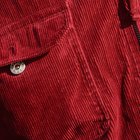A wetsuit is a tight-fitting garment that athletes use in a wide variety of water sports including swimming, surfing and wake boarding. A wetsuit's design allows a small amount of water to seep in between the skin and the suit. Your body quickly heats this water, which helps to keep you warm in cold water temperatures.
Well-Made Suit
Typically manufactured from double-lined neoprene or with neoprene laminated to a fabric such as stretch nylon, wetsuits are constructed with functionality in mind. In thinner suits, the flexible nylon material Lycra is used. Manufacturers use different techniques—including gluing, blind stitching and taping—to increase the seal at the seams of the suit. They also commonly sew in a flap of material that lies underneath the zipper to reduce water seepage.
Snug and Stretchy
You should purchase a wet suit that fits well to help increase insulation and comfort. Your wetsuit should fit snugly but should not restrict movement or breathing. A tight-fitting wetsuit will provide a good seal at the ankles, wrists and neck. The fit of the suit should minimize the amount of water that enters the suit, because the smaller the amount of water inside, the better your body will retain heat. If you purchase a wetsuit that is too loose, it will fill with water, restricting your movement and failing to retain heat.
Suit Styles
Five types of wetsuits are available for purchase. A shorty is a one-piece, short-sleeved and shorts-styled wetsuit. The three-quarter wetsuit is a one-piece suit featuring short sleeves and legs that extend to the ankles. A full-length wetsuit has sleeves that extend to the wrists and legs that extend to the ankles. A full suit is a one-piece suit that can have either short or long legs. The Farmer John or Farmer Jane is a two-piece suit styled like bib overalls for individuals with an odd leg-to-torso figure.
Triathlon Temperatures
The water conditions you prefer will dictate when to wear a suit. Generally speaking, the warmer the water the less protection you need, and the colder the water the more protection you need. Commercial wetsuit sellers suggest in water 70 to 85 degrees Fahrenheit, you should use a wetsuit that is 1/16 to 1/8 inch thick. In water 50 to 75 degrees Fahrenheit, you should use a wetsuit that is 3/16 to 1/4 inch thick. Lycra is the best fabric to use for diving in warm and shallow waters. Triathlon competitors should note that the USA Triathlon, the national governing body for the triathlon, allows a wetsuit in water 78 degrees or cooler, and permits wetsuits in 79 to 84-degree water although they make you ineligible for awards. No competitor is permitted to wear a wetsuit in water 85 degrees or above.
Related Articles

Dry Suits vs. Wetsuits

What Is a Thermal Shirt?

How to Measure a Man for a Portly Suit

How to Shrink 100 Percent Cotton Brief ...

What Do You Wear When Going Canoeing?

Rash Guard for Swimming

Instructions for Sewing Basketball ...

How to Take Measurements for a Raincoat

How to Clean Viscose Shawls

What Type of Clothing Do People in the ...

How to Clean a Simpson Racing Suit

What Is a Textile Motorcycle Jacket?

Travelpro Suit Carrier Instructions

The Differences of Neoprene & Thinsulate

How to Make a Letterman Jacket Smaller

Types of Men's Vests

How to Put on Padded Bike Shorts

Water-Resistant Vs. Waterproof Boots

How to Make a Sumo Costume

How to Get the Stiffness Out of ...
References
Writer Bio
A 2010 arrival to the world of professional writing, Ronaldo Dixon, an athlete since a young age, helped to form, train and maintain a nationally ranked WVU Club boxing team. Dixon holds a Bachelor of the Arts in business administration, communications and sociology from West Virginia University.